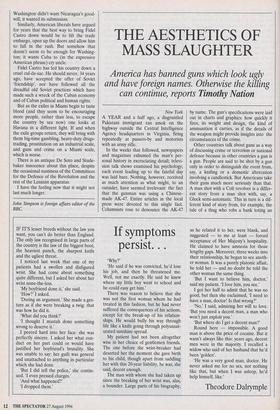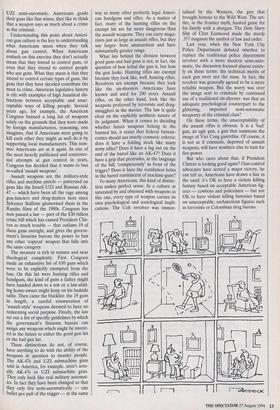THE AESTHETICS OF MASS SLAUGHTER
America has banned guns which look ugly
and have foreign names. Otherwise the killing can continue, reports Timothy Nation New York A YEAR and a half ago, a disgruntled Pakistani immigrant ran amok on the highway outside the Central Intelligence Agency headquarters in Virginia, firing repeatedly at passers-by and motorists with an army rifle.
In the weeks that followed, newspapers and magazines exhumed the man's per- sonal history in excruciating detail; televi- sion talk shows examined his psychology; each event leading up to the fateful day was laid bare. Nothing, however, received as much attention as what might, to an outsider, have seemed irrelevant: the fact that the gunman was using a Chinese- made AK-47. Entire articles in the local press were devoted to this single fact. Columnists rose to denounce the AK-47 by name. The gun's specifications were laid out in charts and graphics: how quickly it fires, its weight and design, the kind of ammunition it carries, as if the details of the weapon might provide insights into the circumstances of the crime.
Other countries talk about guns as a way of discussing crime or terrorism or national defence because in other countries a gun is a gun. People are said to be shot by a gun only in order to distinguish the event from, say, a knifing or a domestic altercation involving a candlestick. But Americans take their guns much more seriously than that. A man shot with a Colt revolver is a differ- ent story from a man shot with, say, a Glock semi-automatic. This in turn is a dif- ferent kind of story from, for example, the tale of a thug who robs a bank toting an UZI semi-automatic. Americans grade their guns like fine wines; they like to think that a weapon says as much about a crime as the criminal.
Understanding this point about Ameri- can gun culture is the key to understanding what Americans mean when they talk about gun control. When Americans embark on this exercise they don't actually mean that they intend to control guns, or even that they intend to control people who use guns. What they mean is that they intend to control certain types of guns, the guns that they have decided contribute the most to crime. American legislative history is rife with examples of high Jesuitical dis- tinctions between acceptable and unac- ceptable ways of killing people. Several years ago, for example, the American Congress banned a long list of weapons solely on the grounds that they were made by foreign manufacturers, reasoning, one imagines, that if Americans were going to kill each other they might as well do it by supporting local manufacturers. This sum- mer Americans are at it again. In one of the most heavily publicised and controver- sial attempts at gun control in years, Congress has decided that it wants to ban so-called 'assault weapons'.
Assault weapons are the military-style rifles and machine pistols — patterned on guns like the Israeli UZI and Russian AK- 47 — which have been all the rage among gun-fanciers and drug-dealers here since Sylvester Stallone glamorised them in the Rambo films of the 1980s. Congress has now passed a law — part of the $30 billion crime bill which has caused President Clin- ton so much trouble — that outlaws 19 of these guns outright, and gives the govern- ment's firearms bureau the power to ban any other 'copycat' weapon that falls into the same category.
The measure is rich in nuance and near theological complexity. First Congress made an exhaustive list of 650 guns which were to be explicitly exempted from the ban. On this list were hunting rifles and handguns, the kind of guns a father might have handed down to a son or a law-abid- ing home-owner might keep on his bedside table. Then came the blacklist: the 19 guns in length, a careful enumeration of `assault-style' weapons deemed to have no redeeming social purpose. Finally, the law set out a list of specific guidelines by which the government's firearms bureau can assign any weapons which might be invent- ed in the future to either the good gun list or the bad gun list. These distinctions do not, of course, have anything to do with the ability of the weapons in question to murder people. The AK-47s and UZI submachine guns sold in America, for example, aren't actu- ally AK-47s or UZ1 submachine guns. They only look like real military automat- ics. In fact they have been changed so that they only fire semi-automatically — one bullet per pull of the trigger — in the same way as many other perfectly legal Ameri- can handguns and rifles. As a matter of fact, many of the hunting rifles on the exempt list are far more dangerous than the assault weapons. They can carry maga- zines just as large as assault rifles, but they use larger- bore ammunition and have substantially greater range.
What lies behind the division between good guns and bad guns is not, in fact, the question of how lethal the gun is, but how the gun looks. Hunting rifles are exempt because they look like, well, hunting rifles. Revolvers are exempt because they look like the six-shooters Americans have known and used for 200 years. Assault rifles, on the other hand, look like the weapons preferred by terrorists and drug- smugglers in the movies. The law is quite clear on the explicitly aesthetic nature of its judgment. When it comes to deciding whether future weapons belong to the banned list, it states that federal bureau- cratics should use strictly cosmetic criteria: does it have a folding stock like many army rifles? Does it have a lug nut on the end of the barrel like an AK-47? Does it have a grip that protrudes, in the language of the bill, 'conspicuously' in front of the trigger? Does it have the ventilation holes in the barrel reminiscent of machine-guns?
To many Americans, this kind of distinc- tion makes perfect sense. In a culture as saturated by and obsessed with weapons as this one, every type of weapon carries its own psychological and sociological impli- cations. The Colt revolver was immor-
talised by the Western, the gun that brought honour to the Wild West. The set- tler, in the frontier myth, hunted game for his family with a shotgun. The Dirty Harry film of Clint Eastwood made the sturdy .357 magnum the symbol of law and order.
Last year, when the New York City Police Department debated whether to replace the traditional police department revolver with a more modern semi-auto- matic, the discussion focused almost entire- ly on these terms: the technical merits of each gun were not the issue. In fact, the revolver was generally agreed to be a more reliable weapon. But the worry was over the image sent to criminals by continued use of a traditional six-shooter: was that an adequate psychological counterpart to the
glittering, imported semi-automatic weaponry of the criminal class?
On these terms, the unacceptability of the assault rifles is obvious. It is a 'bad' gun, an ugly gun, a gun that summons the image of Viet Cong guerrillas. Of course, it is not as if criminals, deprived of assault weapons, will have nowhere else to turn for fire-power.
But who cares about that, if President Clinton is looking good again? Gun-control advocates have scored a major victory, he can tell us, Americans have drawn a line in the sand: it's OK to have a violent killing fantasy based on acceptable American fig- ures — cowboys and policemen — but not OK to have violent killing fantasies based on unacceptable, unArnerican figures such as terrorists or Colombian drug barons.



























































 Previous page
Previous page